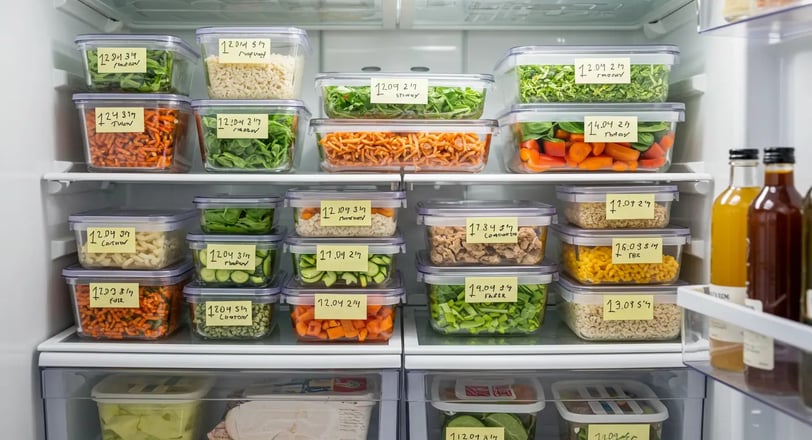
How to Store Food Properly: Keep It Fresh and Safe Longer
Begin with the fundamentals of proper food storage. This topic covers essential guide-lines such as temperature control, proper handling, and time limits to maintain food quality and safety.
FOOD SAFETY AND STORAGE
Mae Ellison
2/27/20255 min read


How to Store Food Safely
Short Description:
Learn how to store food safely and keep it fresh longer. From proper refrigeration and freezing to organizing your pantry, discover the best practices for food storage to prevent spoilage, reduce waste, and ensure safety.
Why Proper Food Storage is Crucial
Proper food storage plays a vital role in keeping your meals safe, fresh, and nutritious. If not handled properly, food can spoil quickly, leading to waste and potential health risks like foodborne illnesses. According to guidelines from the FDA, USDA, and CDC, storing food safely is one of the most important things you can do to ensure the health of your family and prevent contamination.
Whether you’re stocking your pantry, fridge, or freezer, understanding the best storage practices can help extend the shelf life of your ingredients, preserve their taste, and reduce the risk of foodborne pathogens like Salmonella and E. coli. In this article, we’ll guide you through the safest methods of food storage, offering tips and tricks that are easy to implement in any kitchen.
Best Practices for Storing Perishable Foods
Refrigeration and Freezing Basics
One of the most important rules of food safety is storing food at the right temperature. The USDA recommends that your refrigerator should be set at or below 40°F (4°C) and your freezer should be at 0°F (-18°C). These temperatures slow down the growth of harmful bacteria and help preserve the freshness of your food.
Meats, dairy products, eggs, and other perishable items should always be refrigerated.
Freezing helps preserve food for longer periods, but it doesn’t kill bacteria—only prevents it from growing. Proper packaging is key to avoiding freezer burn and keeping your frozen foods at their best.
Storing Fruits and Vegetables
Different types of produce have different storage needs. Some fruits and vegetables require refrigeration, while others thrive when stored at room temperature.
Leafy greens, berries, and cut vegetables should be stored in the fridge to keep them fresh longer.
Bananas, tomatoes, and potatoes should be stored at room temperature away from direct sunlight.
Use the crisper drawer of your fridge for optimal humidity levels for most fresh produce.
Using Proper Food Storage Containers
The right storage container can make a huge difference in how long your food stays fresh. Airtight containers are essential for storing most foods, as they keep out moisture and air, both of which accelerate spoilage.
For fruits and vegetables, store them in perforated plastic bags or containers that allow for airflow.
Glass jars, plastic bins, and vacuum-seal bags are perfect for storing grains, meats, leftovers, and other perishable foods. These containers help lock in freshness and prevent contamination.
Long-Term Food Storage Techniques
Canning and Preserving Food
Canning is a great method for long-term food storage. By sealing food in jars and heating it to kill bacteria, you can preserve fruits, vegetables, meats, and even sauces for months or years.
Follow proper canning techniques to ensure food is safely preserved. Always sterilize jars and lids to prevent the growth of mold or bacteria.
Canned food can be stored in a cool, dark place and remains safe to eat for extended periods when done correctly.
Freezing for Extended Shelf Life
Freezing is one of the most effective methods for preserving food. It’s ideal for meats, vegetables, and leftovers.
Always vacuum seal or use freezer-safe containers to keep the air out and prevent freezer burn.
Label all frozen items with the date they were stored to ensure they are used before they lose quality.
Dehydrating and Vacuum Sealing
Dehydration removes moisture from food, which inhibits the growth of bacteria and mold. It’s a great method for preserving fruits, vegetables, and even meats.
Vacuum sealing is another excellent long-term storage method, as it helps preserve food quality and extends shelf life.
Foods that have been dehydrated or vacuum-sealed should be stored in a cool, dark place, away from heat and moisture.
How to Organize Your Food Storage Space
Create a Designated Storage Area
It’s important to have a well-organized space for all your food. A dedicated storage area ensures that your food stays fresh, and it helps you find items easily when you need them.
Use shelves, bins, and drawer organizers to separate your food by category (e.g., dry goods, canned foods, refrigerated items).
Keep like foods together—group all canned goods, grains, and spices in one area, and all fruits, veggies, and dairy in the fridge.
FIFO (First In, First Out) System
The FIFO system is an easy way to make sure older food gets used first, reducing the risk of spoilage.
Arrange items so that the oldest items are in the front and the newer items are placed behind them.
This simple method ensures that you use up food before it expires and keeps your pantry organized.
Keep Storage Areas Clean and Safe
Regular cleaning is essential for keeping your food storage areas safe from pests and contamination.
Clean your fridge, freezer, and pantry at least once a month. Wipe down surfaces and check for any expired or spoiled items.
Make sure your pantry is dry and free from pests. Use sealed containers to prevent infestations.
Common Food Storage Mistakes to Avoid
Improper Temperature Management
Food storage temperatures are critical for maintaining food safety. Storing food at too high or low a temperature can cause bacteria to grow or food to spoil prematurely.
Always check your fridge and freezer temperatures regularly.
Don’t store perishable items in the danger zone, which is between 40°F (4°C) and 140°F (60°C), where bacteria grow rapidly.
Overpacking Storage Spaces
It’s tempting to pack your fridge or freezer as full as possible, but overcrowding can block air circulation, which leads to uneven cooling or freezing.
Leave some space between items to ensure proper airflow and temperature regulation.
Avoid stacking frozen foods too tightly, as air needs to circulate to maintain consistent freezing temperatures.
Storing Foods Together Improperly
Certain foods should not be stored together, as they can spoil each other more quickly or cause cross-contamination.
Raw meats should always be stored away from ready-to-eat foods like salads or cooked leftovers.
Keep strong-smelling foods (e.g., onions, garlic) away from fruits to avoid flavor contamination.
How to Use Food Storage to Prevent Wastage
Best Before Dates and Expiration Dates
Knowing the difference between "best before" and "use by" dates can help you avoid wasting food that’s still safe to eat.
"Best before" dates indicate the period during which food is at its best quality, while "use by" dates are critical for safety.
Regularly check your pantry and fridge for expired items, and use FIFO to avoid food waste.
Portioning and Meal Prep
Meal prepping and portioning food can help prevent overbuying and reduce food waste.
Cook meals in advance and portion them out for storage in airtight containers.
Label and date each portion to ensure it is used within a safe time frame.
Using Leftovers Efficiently
Leftovers are a great way to minimize food waste, but they need to be stored properly.
Cool leftovers quickly and refrigerate them within two hours.
Label and freeze portions for later use to ensure nothing goes to waste.
Conclusion: Safeguarding Your Food and Health
Proper food storage is essential for maintaining the safety, freshness, and quality of your food. By following the simple guidelines outlined above, you can significantly reduce the risk of foodborne illnesses, extend the shelf life of your ingredients, and minimize waste.
Remember to always check temperatures, use airtight containers, and practice proper organization in your kitchen. By storing food safely, you’re not only protecting your health but also saving money and reducing unnecessary waste.
